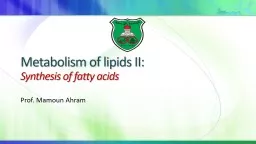

Synthesis of fatty acids Prof Mamoun Ahram Resources This lecture Lippincotts Biochemistry Ch 16 Mito to cyto transport of acetylCoA When ATP increases ATP inhibits isocitrate dehydrogenase ID: 907963
Download Presentation The PPT/PDF document "Metabolism of lipids II:" is the property of its rightful owner. Permission is granted to download and print the materials on this web site for personal, non-commercial use only, and to display it on your personal computer provided you do not modify the materials and that you retain all copyright notices contained in the materials. By downloading content from our website, you accept the terms of this agreement.
Slide1
Metabolism of lipids II:Synthesis of fatty acids
Prof. Mamoun Ahram
Slide2Resources
This lecture
Lippincott’s Biochemistry, Ch. 16
Slide3Mito to cyto transport of acetyl-CoA
When ATP increases:
ATP inhibits isocitrate dehydrogenase
Citrate is transported into the cytosol
Citrate is cleaved into oxaloacetate and acetyl CoA by ATP citrate lyase
Slide4Synthesis of malonyl-CoA
Acetyl CoA carboxylase (ACC) transfers a carbon from CO2 (as a bicarbonate ) via biotin (vitamin B7), which is covalently bound to a
lysyl
residue of the ACC.
ATP is needed.
The reaction is a rate-limiting reactionACC is an allosteric polymeric enzymeACC is inactivated byDepolymerization by palmitoyl-CoA.Phosphorylation by AMPK
ACC synthesis increases by Excess calories via the transcription factor carbohydrate response element–binding protein (
ChREBP)Insulin via the transcription factor sterol regulatory element–binding protein-1c (SREBP-1c).
Notes: A low-calorie or a high-fat, low-carbohydrate is inhibitory of ACC synthesis.ACC synthesis is also upregulated by carbohydrate Fatty acid synthase is similarly regulated.
Slide5Metformin
Metformin lowers plasma TAG through
Activation of AMPK, resulting in inhibition of ACC activity (by phosphorylation) and inhibition of ACC and fatty acid synthase expression (by decreasing SREBP-1c).
Lowering blood glucose by increasing AMPK-mediated glucose uptake by muscle.
Slide6Fatty acid synthase (FAS)
A multifunctional,
homodimeric
enzyme
Each FAS monomer is
multicatalytic with six different enzymic domains.It is associated with a phosphopantetheine-containing acyl carrier protein (ACP) domain. Phosphopantetheine, a derivative of pantothenic acid (vitamin B5), carries acyl units on its terminal thiol (–SH) group and presents them to the catalytic domains of FAS.
It also is a component of CoA.
t
hioesterase
t
hioesterase
Slide7Slide83-Ketoacyl–ACP synthase
Malonyl/acetyl CoA–ACP
transacylase
Energy
Slide9Condensation, reduction, dehydration, reduction
3-Ketoacyl–ACP synthase
3-Ketoacyl–ACP
reductase
3-Hydroxyacyl–ACP
dehydratase
Enoyl–ACP reductase
Slide10Slide11The stoichiometry of palmitate synthesis
Slide12Sources of molecules
Slide13Further elongation
Location: smooth endoplasmic reticulum
Different enzymes are needed.
Two-carbon donor: Malonyl CoA
Source of electrons: NADPH
No ACP or multifunctional enzyme is needed.
Note: the brain has additional enzymes allowing it to produce the very-long-chain fatty
acids ([VLCFA] over 22 carbons)
Location: mitochondriaTwo-carbon donor: Acetyl CoASource of electrons: NADPH and NADHSubstrates: fatty acids shorter than 16
Source of carbons
Source of Electrons
Source of carbons
Sources of Electrons
Slide14Chain desaturation
Enzymes: fatty acyl CoA desaturases
Substrates: long-chain fatty acids
Location: smooth endoplasmic reticulum
Acceptor of electrons: oxygen (O2), cytochrome b5, and its flavin adenine dinucleotide (FAD)-linked reductase
Donor of electrons: NADH The first double bond is inserted between carbons 9 and 10, producing oleic acid, 18:1(9), and small amounts of palmitoleic acid, 16:1(9).
Humans have carbon 9, 6, 5, and 4 desaturases but cannot introduce double bonds from carbon 10 to the ω end of the chain. This is the polyunsaturated ω-6 linoleic acid and ω-3 linolenic acid are essential.
Palmitoleic acid
Oleic acid
Slide15Triacylglycerol structure and synthesis
The fatty acid on carbon 1 is typically saturated, that on carbon 2 is typically unsaturated, and that on carbon 3 can be either.
Synthesis involved three steps:
Glycerol 3-phosphate synthesis
Liver vs. Adipose tissue
Activation of fatty acids
Synthesis of triacylglycerol
GLUT-4
Insulin
Slide16Synthesis of triacylglycerol
Acyltransferase
Acyltransferase
Acyltransferase
Phosphatase
Adipose tissue
Stooge as lipid droplets
Liver
Little storage
Mainly packaged in VLADL